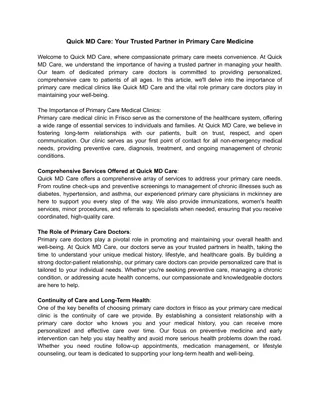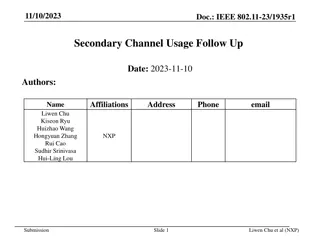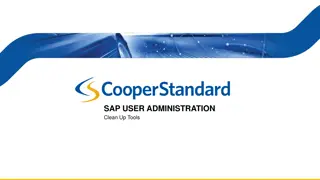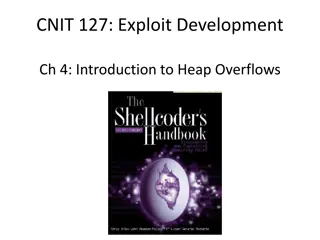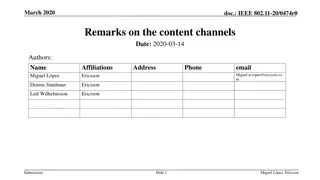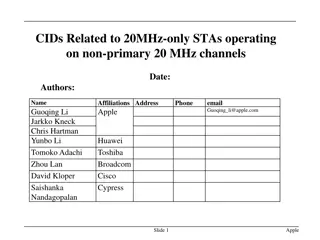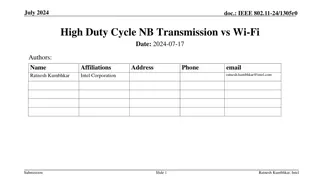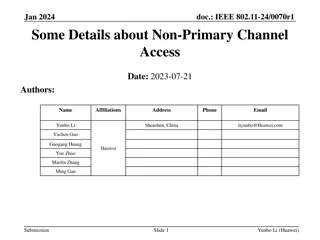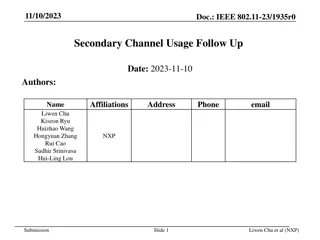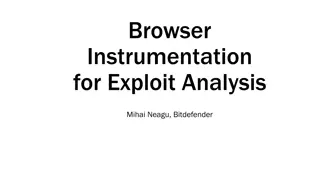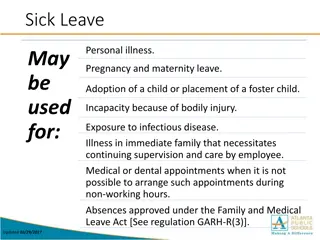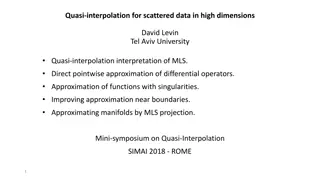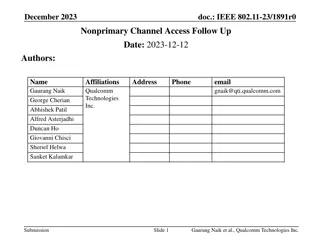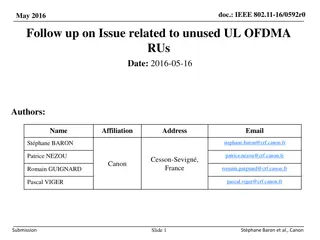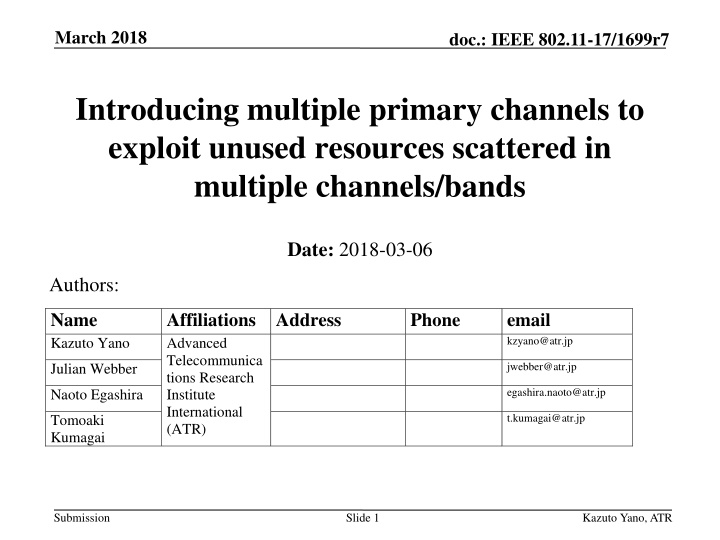
Exploiting Multiple Primary Channels for Enhanced Wireless LAN Throughput
Enhance wireless LAN system throughput by introducing multiple primary channels (PCHs) to balance and increase achievable throughput, addressing the demands of high-traffic applications and future technologies like VR/AR. This presentation discusses utilizing unused resources in multiple channels to optimize system performance and meet increasing wireless traffic demands effectively.
Uploaded on | 1 Views
Download Presentation

Please find below an Image/Link to download the presentation.
The content on the website is provided AS IS for your information and personal use only. It may not be sold, licensed, or shared on other websites without obtaining consent from the author. If you encounter any issues during the download, it is possible that the publisher has removed the file from their server.
You are allowed to download the files provided on this website for personal or commercial use, subject to the condition that they are used lawfully. All files are the property of their respective owners.
The content on the website is provided AS IS for your information and personal use only. It may not be sold, licensed, or shared on other websites without obtaining consent from the author.
E N D
Presentation Transcript
March 2018 doc.: IEEE 802.11-17/1699r7 Introducing multiple primary channels to exploit unused resources scattered in multiple channels/bands Date: 2018-03-06 Authors: Name Kazuto Yano Affiliations Address Advanced Telecommunica tions Research Institute International (ATR) Phone email kzyano@atr.jp jwebber@atr.jp Julian Webber egashira.naoto@atr.jp Naoto Egashira t.kumagai@atr.jp Tomoaki Kumagai Submission Slide 1 Kazuto Yano, ATR
March 2018 doc.: IEEE 802.11-17/1699r7 Abstract Due to the increasing traffic demand of wireless LAN, we need to enhance the system throughput. We have presented in the January F2F meeting [7] The concept of introducing multiple primary channels (PCHs) to enhance the achievable throughput. The average achievable throughput can be increased by employing two PCHs when the background traffic on the two PCHs is balanced [7]. In this presentation... Some new use cases of multiple PCHs are introduced. The average achievable throughput can be also increased by using two PCHs even when the amount of background traffic is instantaneously un-balanced. Submission Slide 2 Kazuto Yano, ATR
March 2018 doc.: IEEE 802.11-17/1699r7 Background (1) (Increase of off-loading traffic from cellular system) The amount of wireless LAN traffic is still increasing due to expansion of applications and off-loading of cellular traffic. To meet the increasing demand, enhancement of system throughput of the wireless LAN is still necessary. WLAN traffic becomes 4 times in 5 years. Growth of IP traffic forecasted by Cisco [1]. Submission Slide 3 Kazuto Yano, ATR
March 2018 doc.: IEEE 802.11-17/1699r7 Background (2) (High-traffic-and-reliability usage) The wireless LAN is going to be used for some applications that require high QoS. Remote monitoring/inspection using high-definition (HD) network cameras. Real-time exchange of dynamic map information (several Mb/s ~ ten s of Mb/s) among many self-driving wheelchairs and guidance robots for their control and management. For high-traffic-and-reliability usage, the wireless LAN needs to provide enough transmission chances and bandwidth to a STA. Access point Self-driving wheelchair Upload sensor and video data to construct dynamic map. Download dynamic map for mobility control and environment cognition, etc. Self-driving guidance robot Submission Slide 4 Kazuto Yano, ATR
March 2018 doc.: IEEE 802.11-17/1699r7 Background (3) (Emerging VR/AR applications) Virtual reality and Augmented reality will also put high demands on the future WLAN. To experience a low resolution of 360 degrees, VR would require at least 25 ~ 100 Mbps throughput per user for streaming [2]. AR requires more than 100 Mbps of user throughput and almost ms-order latency [2]. When several users try to connect to an AP, the current WLAN will not be able to support the required QoS. Real-time transmission of information, images and audio and video. High-throughput and Low-latency. Many AR users accessing the AP in a confined space. Submission Slide 5 Kazuto Yano, ATR
March 2018 doc.: IEEE 802.11-17/1699r7 Example of spectrum usage in a real environment 500 We conducted measurements of channel usage at a main-line railway station in Japan [3]. Measured spectrogram shows that channel availability changes dynamically, but there are many short unused resources with durations of typically 10-70 ms in some channels. If we can utilize these scattered unused resources at a STA, we can obtain more transmission chances and can improve QoS. 400 300 200 100 0 Ch. 1 (Left) 2.4 and (Right) 5 GHz Spectrogram 6 108 112 116 Submission Slide 6 Kazuto Yano, ATR
March 2018 doc.: IEEE 802.11-17/1699r7 Issue of current wireless LAN when channel load is high In current IEEE 802.11 wireless LAN, a BSS sets one primary channel (PCH) on which each STA invokes the back-off procedure to obtain a transmission opportunity (TXOP) [4]. However, if channel load of the PCH is relatively high, some STAs would hardly obtain enough TXOPs to achieve required QoS even though unused resources exist on other channels. Frequency Frame from other STA Own transmitted frame PCH Time These unused resources are not available. Submission Slide 7 Kazuto Yano, ATR
March 2018 doc.: IEEE 802.11-17/1699r7 Load balancing by switching PCH and its limitation One of the possible approaches to solve this problem is to switch the PCH of each BSS so as to balance the average channel load of each channel. An AP selects a channel with enough available resource by using QLoad Report for management of OBSS defined in IEEE 802.11aa [4]. A non-AP STA searches a BSS with enough available resource by channel scanning and quickly sets up a link to the BSS by FILS defined in IEEE 802.11ai [5]. However, instantaneous channel load varies, and unused resources randomly and independently occur among channels even when the average channel load is balanced. QoS of each traffic will be improved if such unused resources are available. Submission Slide 8 Kazuto Yano, ATR
March 2018 doc.: IEEE 802.11-17/1699r7 Introducing multiple PCHs on multiple channels/bands To utilize such scattered unused resources, we propose to set multiple PCHs in one or more frequency bands. A STA independently invokes the back-off process on each PCH. The number of available TXOPs can be increased, and thus the achievable throughput can be enhanced. Frequency Band A PCH 1 PCH 2 Band B PCH 3 Time Submission Slide 9 Kazuto Yano, ATR
March 2018 doc.: IEEE 802.11-17/1699r7 How to access multiple PCHs We consider three ways to transmit a frame on PCHs. a. Concurrent (asynchronous) transmission on multiple PCHs (CT) : Asynchronously transmit a frame on each PCH if a transmission chance is obtained on the PCH. CT can be used only when inter- channel interference between PCHs is negligible. b. Simultaneous transmission on multiple PCHs (ST) : Transmit a channel-bonded frame across multiple PCHs after obtaining TXOPs on multiple PCHs. ST is available even when inter-channel interference between PCHs is not negligible if OFDM(A) is used. c. Non-concurrent transmission (Non-CT): Transmit a frame only on one PCH if neither ST nor CT is available. Submission Slide 10 Kazuto Yano, ATR
March 2018 doc.: IEEE 802.11-17/1699r7 Queue sharing among PCHs To effectively exploit unused resources scattered in the time and frequency domains even when a STA only has one data stream, EDCA queue is shared by multiple PCHs. Submission Slide 11 Kazuto Yano, ATR
March 2018 doc.: IEEE 802.11-17/1699r7 Loading simulation (1/3) We assume one target BSS, and 8 legacy OBSSs as the source of background traffic. Each BSS has 2 non-AP STAs. 2 PCHs (ch 36 and ch 100) are set in 5 GHz band. The target BSS can use both PCHs. Each OBSS can use either of PCHs. Both ch 36 and ch 100 are used by 4 OBSSs. Each STA has downlink traffic with 96000-byte payload. The target BSS has full-buffer traffic to evaluate achievable throughout. Each OBSS has CBR traffic. Packet arrival interval is fixed to 100 ms, or uniformly random within a range of 25 250 ms or 8 400 ms. The multi-PCH performance is compared with single-PCH. One RF chain is employed for each PCH. MCS index is fixed to 4. Submission Slide 12 Kazuto Yano, ATR
March 2018 doc.: IEEE 802.11-17/1699r7 Loading simulation (2/3) For simplicity, we conduct simulations based on 802.11ac with maximum transmission bandwidth of 80 MHz. Following cases are compared: The target BSS uses one PCH (ch 36). The target BSS performs concurrent transmission (CT). The target BSS performs simultaneous transmission (ST). It waits up to 120 s to obtain TXOP on both PCHs. If a STA judges that it cannot obtain TXOP on another PCH, it immediately transmits a frame on one PCH with non- concurrent transmission (non-CT). Submission Slide 13 Kazuto Yano, ATR
March 2018 doc.: IEEE 802.11-17/1699r7 Loading simulation (3/3) Area size : 60 m x 60 m (20 m x 20 m segment, 3 x 3 segments) Position of AP/STA : uniformly random in a segment Propagation model : based on the residential scenario (SS1) in the IEEE 802.11 TGax simulation scenarios [6]. Tx power : 20 dBm per PCH (AP), 15 dBm per PCH (STA) Submission Slide 14 Kazuto Yano, ATR
March 2018 doc.: IEEE 802.11-17/1699r7 Simulation results (1/3) Packet arrival interval : 100 ms (fixed, balanced traffic) Average offered traffic load of OBSSs : 35 % (in PHY layer) CT improves 10%, 50%, 90% throughput by 107%, 103%, 94% without degrading OBSS s performance. ST improves 10%, 50%, 90% throughput by 77%, 81%, 75%. Degradation due to insufficient SNR. Target BSS OBSSs (8 BSSs) Submission Slide 15 Kazuto Yano, ATR
March 2018 doc.: IEEE 802.11-17/1699r7 Simulation results (2/3) Packet arrival interval : 25 ms ~ 250 ms Average offered traffic load of OBSSs : 35 % (in PHY layer) CT improves 10%, 50%, 90% throughput by 114%, 102%, 93% without degrading OBSS s performance. ST improves 10%, 50%, 90% throughput by 66%, 69%, 71%. Target BSS OBSSs (8 BSSs) Submission Slide 16 Kazuto Yano, ATR
March 2018 doc.: IEEE 802.11-17/1699r7 Simulation results (3/3) Packet arrival interval : 8 ms ~ 400 ms Average offered traffic load of OBSSs : 35 % (in PHY layer) CT improves 10%, 50%, 90% throughput by 121%, 98%, 93% without degrading OBSS s performance. ST improves 10%, 50%, 90% throughput by 64%, 66%, 75%. Target BSS OBSSs (8 BSSs) Submission Slide 17 Kazuto Yano, ATR
March 2018 doc.: IEEE 802.11-17/1699r7 Summary (1/2) We have proposed to introduce multiple PCHs to obtain more transmission chances and to improve the performance of the wireless LAN by exploiting unused resources scattered in time and frequency domains. There are three ways to use multiple PCHs: Simultaneous (channel-bonded) transmission on multiple PCHs Concurrent (asynchronous) transmission on multiple PCHs Non-concurrent transmission Submission Slide 18 Kazuto Yano, ATR
March 2018 doc.: IEEE 802.11-17/1699r7 Summary (2/2) We have confirmed through computer simulation that the proposed methods can achieve 1.6 ~ 2.0 times higher 50%- throughput than current single-PCH transmission under both balanced and un-balanced background traffic. Introducing multiple PCHs will be efficient to provide more transmission chances and increased bandwidth to a STA. It will help to support the following use cases: Remote monitoring/inspection using high-definition (HD) network cameras. Real-time exchange of dynamic map information (several Mb/s ~ ten s of Mb/s) among many self-driving wheelchairs and guidance robots for their control and management. Virtual reality and Augmented reality. Submission Slide 19 Kazuto Yano, ATR
March 2018 doc.: IEEE 802.11-17/1699r7 Straw Poll Do you think that IEEE 802.11 wireless LAN group should further investigate/discuss introduction of multiple primary channels for meeting future demand on the wireless LAN? Yes: No: Abstain: Submission Slide 20 Kazuto Yano, ATR
March 2018 doc.: IEEE 802.11-17/1699r7 References [1] Cisco, Cisco Visual Networking Index: Global Mobile Data Traffic Forecast Update, 2016 2021, Cisco White Paper C11-738429-00, February 2017. [2] Mushroom Networks, Bandwidth requirements for Virtual Reality (VR) and Augmented Reality (AR) - infographic 2017. [3] doc. IEEE 802.11-17/0767r0. [4] IEEE 802.11-2016. [5] IEEE 802.11ai-2016. [6] doc. IEEE 802.11-14/0980r16. [7] doc. IEEE 802.11-17/1699r6. Submission Slide 21 Kazuto Yano, ATR
March 2018 doc.: IEEE 802.11-17/1699r7 Appendix Submission Slide 22 Kazuto Yano, ATR
March 2018 Simultaneous transmission on multiple PCHs doc.: IEEE 802.11-17/1699r7 If transmission chances are obtained on multiple PCHs, a channel-bonded frame is transmitted across the PCHs. If a STA obtains a TXOP on a PCH, it may defer its frame transmission until another PCH finishes back-off to perform ST. If the frequency separation between PCHs is large, a high frequency-diversity gain is expected by ST. Frequency Waiting to finish back- off on other PCH Back-off slot Back-off finish Band A PCH 1 Secondary channel for PCH 1 PCH 2 Secondary channel for PCH 2 Band B PCH 3 Secondary channel for PCH 3 Time Submission Slide 23 Kazuto Yano, ATR
March 2018 Concurrent transmission on multiple PCHs doc.: IEEE 802.11-17/1699r7 If a transmission chance is obtained on one of the multiple PCHs, a frame is immediately transmitted on that PCH. CT is available only when PCH separation is large so that inter- channel interference is negligible. (On the other hand, ST is available even when the PCH separation is small if OFDM(A) transmission is used.) Frequency Band A PCH 1 Secondary channel for PCH 1 ~~ PCH 2 Secondary channel for PCH 2 Band B PCH 3 Secondary channel for PCH 3 Time Submission Slide 24 Kazuto Yano, ATR
March 2018 doc.: IEEE 802.11-17/1699r7 Non-concurrent transmission If inter-channel interference is not negligible, a STA can transmit a frame only on one PCH at a time even when transmission chances are obtained on multiple PCHs. However, transmission chances will be increased by setting multiple PCHs if unused resources are scattered. Frequency Busy due to inter-channel interference Band A PCH 1 Secondary channel for PCH 1 PCH 2 Secondary channel for PCH 2 Time Submission Slide 25 Kazuto Yano, ATR

